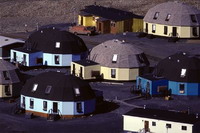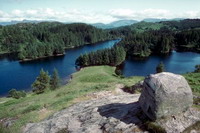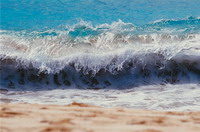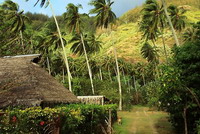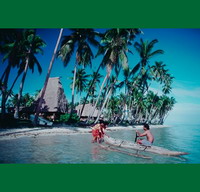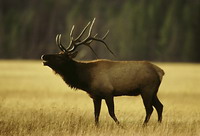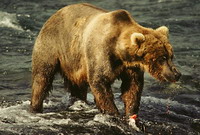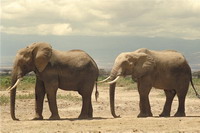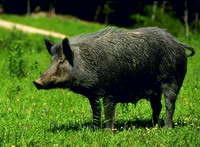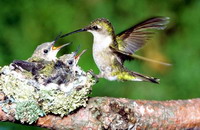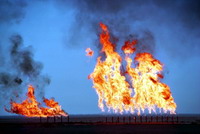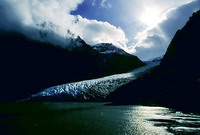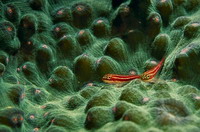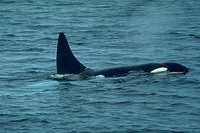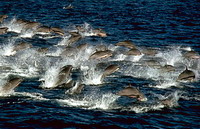The most common mineral on Earth - it is water. Water - a special substance that is modular in three states: solid (at temperatures below 0 ° C - snow and ice), liquid (at temperatures from 0 ° C to 100 ° C - clear liquid without taste and smell) and gaseous (at temperatures above the 0 ° C - water vapor). Water is a part of all living organisms. The human body, for example, 65% consists of water. Fungi, algae and many other plants, especially those with juicy fruit may contain up to 98% of the substance. In the world, contains about 1.5 billion cubic kilometers of water that forms the shell water planet - the hydrosphere. In oceans and seas falls 97.4% water and only 2.6% - is fresh water. Over 3 / 4 of all fresh water located in the glaciers, where it is in solid condition.
Almost a quarter of stocks of fresh water is groundwater, a significant share in the form of permafrost is in the solid state. Only 280 thousand cubic kilometers - is a land surface water (lakes, reservoirs, rivers, marshes), 14 thousand cubic kilometers of fresh water is in the atmosphere in the gaseous state.
Because water can move from one state to another in nature is a continuous process of moving water from the oceans on land and on land - again in the World Ocean. This process is called continuous water cycle in nature. There are small circuit when water evaporating over the ocean, carried a certain distance and falls as rain in another part of the ocean, and a great circuit when moved to dry land from the ocean water comes back to the ocean once, fallen as rain, flowing on the surface or underground leaks.
Water has the ability to expand on heating, cooling - shrink, but only to a temperature of 4 ° C. Upon further cooling, turning into ice water again increases in volume by almost a third. Getting in cracks of rocks and with a lower freezing temperature, the water expands, shattering rocks and changing terrain. This process is part of weathering - destruction. Water is a good solvent, it dissolves but not all substances. The best dissolved in water different salt, gypsum, limestone. Because these soluble rocks in the crust pretty much underground water frequently washes away cavities, which cause the formation of surface failures. Dissolved salt water through the water cycle fall into the oceans and accumulate there, because sea water contains more salt water than land. Water that does not contain salt, can be obtained only in laboratory conditions. In nature, as all the water, even fresh, contains salts that give it a taste.
On dry land, water flows in lower relief, forming a natural water flows (streams, rivers). Each river has a leak - a place where it begins. Source may be an underground source, swamps, lakes, glaciers. Then the river flows toward lower terrain natural cavity, which is called the river valley. Part of the valley, constantly occupied by water flow, called channels. During intense rainfall or when snow melt, flooding occurs, during which water is poured floodplain - the coastal part of the river valley. Some rocks dissolving water, and insoluble species, such as sand and clay, water erodes. Thus deeper channel all the time. Blowup of the earlier river valley floodplains that were once converted into terraces and never filled with water. The final section of the river at the place of its confluence into the sea, lake or another river called the river mouth. Rivers have their tributaries - other rivers, usually with fewer characters. Main river with all its tributaries forms a river system, and the territory from which the river collects its water is called the Basin. Swimming nearby rivers separated from each watershed.
Rivers in soft easily eroded rocks. But if the river on the way there are more solid mountain rocks, with which the river can not cope, they formed Rapids - performances of solid rock above the river bottom as individual boulders, and waterfalls - fall in the Wake, from which water falls almost sheer.
Admission Process of surface and ground water in the river called it power. Rivers fed by rain and underground waters, waters talymy ice and snow. Most rivers have mixed power, so in different seasons of water in the river changes. Changes of the river during the year is called the river regime. After long rain, melting snow in spring or summer melting of glaciers marked the highest level of water in the river - flooding. At a time when the river is fed only by underground waters, there is middle of summer - the lowest level of water in a river.
Rivers is one of the powerful external forces of nature. They perform three types of work: destruction, transfer and deposition of rocks. Destructive techniques rivers called fluvial erosion. Diffuse material carried by the river and deposited in its delta - the plain at the mouth of the river, created by river sediments.

Less than 2% of the land occupied by the lake - natural depression filled with water. By origin lake depressions lakes are divided into several types. Tectonic lake formed by subsidence of the earth's crust in areas of its faults, glacial - vyorani ancient glaciers; balance - the remnant of ancient sea basins, volcanic lakes formed in craters of volcanoes; karst appeared on soluble rocks, estuary - a sea area, separated by sand spits ; zahatni - formed after landslides in the mountains, lakes, old women are remnants of the beds of rivers. Over the water regime of the lake is divided into wastewater, which is derived from at least one river, and closed - of which river does not flow through that accumulate salt in them and they are mostly salt.
For their human needs created many artificial reservoirs, large and small perehorodyvshy River dams, as well as paving the shipping and irrigation channels.
Excessively wet areas of dank vegetation, which have a layer of peat above 30 cm, called swamps. According to distinguish lowland origin, horse-riding and transitional bogs. Lowland bogs are located in the humble parts of the terrain and are powered both by rain and river and groundwater. Horse swamps formed on raised parts of the earth's surface, so only feed on the precipitation.
As a result, the penetration of atmospheric moisture in the earth crust formed by groundwater. Rocks differently passed through a water. Sand and gravel, such as the water passes well. Clay, tight sandstones, frozen soil is waterproof, as water kept. Above the layer of waterproof wood water accumulates to form the aquifer. Nearest to the surface of the temporary lens shape slug called bleak, and the first from the surface aquifer is blocked waterproof layer - groundwater. Between the waterproof layers deposited mizhplastovi water.

Tenth of the land surface area occupied by glaciers. Most are concentrated in the ice covering Antarctica and Greenland glaciers, where ice forms bahatokilometrovu thick. These glaciers are moving slowly due to the plasticity of ice and spovzayuchy the ocean, a huge split in parts, forming icebergs.

Mountain glaciers are less powerful and moving at a slower speed. Descended from the mountains, glaciers slowly melting of feed rivers and lakes.
 English
English

























